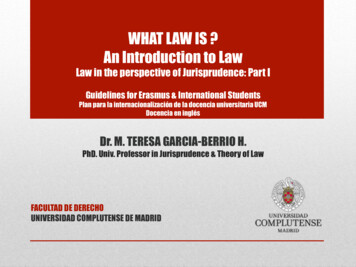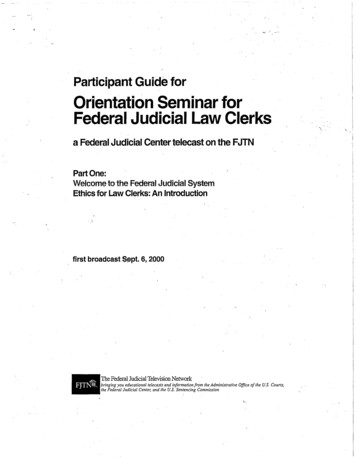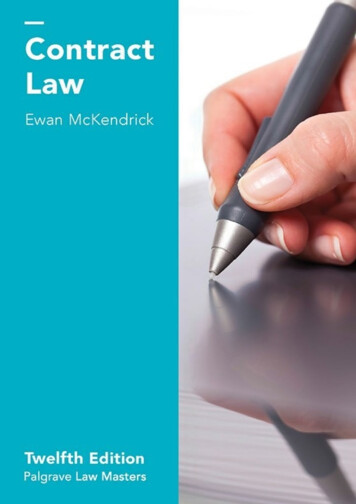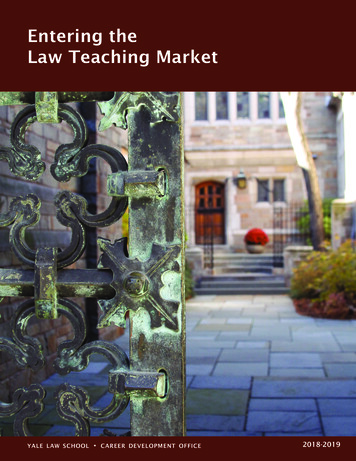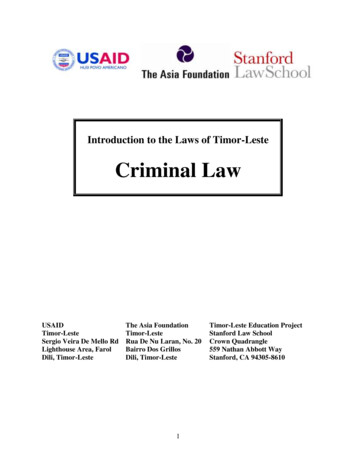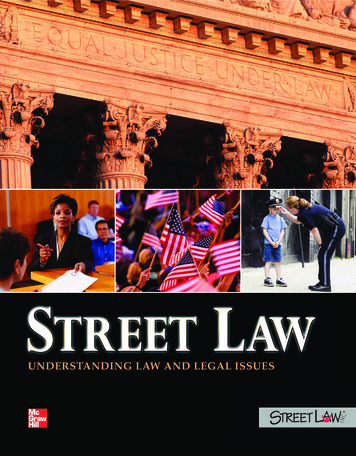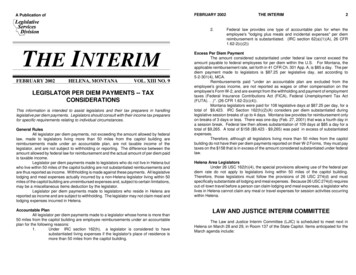
Transcription
FEBRUARY 2002A Publication of2.THE INTERIMFEBRUARY 2002HELENA, MONTANAVOL. XIII NO. 9LEGISLATOR PER DIEM PAYMENTS -- TAXCONSIDERATIONSThis information is intended to assist legislators and their tax preparers in handlinglegislative per diem payments. Legislators should consult with their income tax preparersfor specific requirements relating to individual circumstances.General RulesAll legislator per diem payments, not exceeding the amount allowed by federallaw, made to legislators living more than 50 miles from the capitol building arereimbursements made under an accountable plan, are not taxable income of thelegislator, and are not subject to withholding or reporting. The difference between theamount allowed by federal law for reimbursement and the actual amount of per diem paidis taxable income.Legislator per diem payments made to legislators who do not live in Helena butwho live within 50 miles of the capitol building are not substantiated reimbursements andare thus reported as income. Withholding is made against these payments. All legislativelodging and meal expenses actually incurred by a non-Helena legislator living within 50miles of the capitol building are unreimbursed expenses and, subject to certain limitations,may be a miscellaneous items deduction by the legislator.Legislator per diem payments made to legislators who reside in Helena arereported as income and are subject to withholding. The legislator may not claim meal andlodging expenses incurred in Helena.Accountable PlanAll legislator per diem payments made to a legislator whose home is more than50 miles from the capitol building are employee reimbursements under an accountableplan for the following reasons:1.Under IRC section 162(h), a legislator is considered to havesubstantiated living expenses if the legislator's place of residence ismore than 50 miles from the capitol building.THE INTERIM2Federal law provides one type of accountable plan for when theemployee's "lodging plus meals and incidental expenses" per diemreimbursement is substantiated. (IRC section 62(a)(1)(A), 26 CFR1.62-2(c)(2))Excess Per Diem PaymentThe amount considered substantiated under federal law cannot exceed theamount payable to federal employees for per diem within the U.S. For Montana, theapplicable reimbursement rate, set forth in 41 CFR Ch. 301 App. A, is 85 a day. The perdiem payment made to legislators is 87.25 per legislative day, set according to5-2-301(4), MCA.Reimbursements paid "under an accountable plan are excluded from theemployee's gross income, are not reported as wages or other compensation on theemployee's Form W-2, and are exempt from the withholding and payment of employmenttaxes (Federal Insurance Contributions Act (FICA), Federal Unemployment Tax Act(FUTA). . .)". (26 CFR 1.62-2(c)(4)).Montana legislators were paid for 108 legislative days at 87.25 per day, for atotal of 9,423. IRC Section 162(h)(2)(A) considers per diem substantiated duringlegislative session breaks of up to 4 days. Montana law provides for reimbursement onlyon breaks of 3 days or less. There was one day (Feb. 27, 2001) that was a fourth day ina session break. Federal law then allows substantiation of 109 days at 85 a day for atotal of 9,265. A total of 158 ( 9,423 - 9,265) was paid in excess of substantiatedexpenses.Therefore, although all legislators living more than 50 miles from the capitolbuilding do not have their per diem payments reported on their W-2 Forms, they must paytaxes on the 158 that is in excess of the amount considered substantiated under federallaw.Helena Area LegislatorsUnder 26 USC 162(h)(4), the special provisions allowing use of the federal perdiem rate do not apply to legislators living within 50 miles of the capitol building.Therefore, those legislators must follow the provisions of 26 USC 274(d) and mustspecifically substantiate all lodging and meal expenses. Because 26 USC 274(d) requiresout-of-town travel before a person can claim lodging and meal expenses, a legislator wholives in Helena cannot claim any meal or travel expenses for session activities occurringwithin Helena.LAW AND JUSTICE INTERIM COMMITTEEThe Law and Justice Interim Committee (LJIC) is scheduled to meet next inHelena on March 28 and 29, in Room 137 of the State Capitol. Items anticipated for theMarch agenda include:
FEBRUARY 2002 THE INTERIM3the regular reports from the Judiciary, the AttorneyGeneral/Department of Justice, and the Department of Corrections;a briefing by Ed Smith, Clerk of Supreme Court, on the compilation andreporting, as required by 46-18-604, MCA, of certain sentencinginformation from district courts;items related to the HJR 39 criminal sentencing study; andmember issues.The committee also intends to observe oral arguments before the SupremeCourt during the afternoon of Thursday, March 28. For more information about theCommittee's activities, contact Dave Bohyer by phone at 406-444-3064 or by e-mail atdbohyer@mt.gov, or Chairman Rep. Gail Gutsche.FEBRUARY 2002THE INTERIM prescription drug benefit programs;a health care inventory;redesigning health insurance purchasing pools; andmarket reforms.4Rep. Joe McKenney and Sen. Jon Ellingson encouraged members and studyparticipants to provide any initial recommendations to subcommittee staff to ensure thatall options are available for discussion. A list of all of the options proposed to date will beavailable on the Subcommittee's website prior to the meeting.Contact Gordy Higgins at 444-3064 or by e-mail at gohiggins@mt.gov if youhave questions or comments about the subcommittee's activities. The Subcommitteewebsite may be accessed at: http://leg.mt.gov/Interim Committees/Economic Affairs/index.htm.ECONOMIC AFFAIRS COMMITTEECommittee to Meet Feb. 15.The Economic Affairs Committee will meet onFriday, Feb. 15, in Room 137 of the Capitol. The meeting is tentatively scheduled to beginat 10 a.m. The Department of Labor and Industry will provide its final recommendationsto the committee on workers' compensation fee schedules for chiropractors, physicaltherapists, and occupational therapists.The agenda and other information will be posted on the committee's website byFeb. 1. Contact Gordy Higgins at 444-3064, or by e-mail at gohiggins@mt.gov formore information.SUBCOMMITTEE ON HEALTH CARE AND HEALTHINSURANCESubcommittee to Review Options.The SJR 22 Subcommittee will meet onThursday, Feb. 14, in Room 137 of the Capitol starting at 9 a.m. The tentative agendaincludes an update on Medicaid funding. John Morrison, Insurance Commissioner, will talkabout the findings and conclusions reached as a result of his statewide round-tablediscussions. Morrison will also propose a series of policy options that are designed toreduce the percentage of uninsured Montanans and to make health insurance and healthcare more affordable.The Subcommittee will spend most of the meeting discussing and prioritizingeach of the recommendations raised since the beginning of the interim. Included amongthe many options are: tax credits for the purchase of health insurance;maximizing federal funds;ENVIRONMENTAL QUALITY COUNCILCouncil to Meet Feb 8. . .The full EQC will meet in Helena on Friday, Feb. 8, at8 a.m. in Room 102 of the Capitol. Jim Hill will describe the program capabilities of thestate library's Natural Resource Information System, and Gary Hamel, Legislative FiscalDivision, will report on state wildfire suppression costs. Montana State Universityprofessor Jim Bauder and Montana Bureau of Mines and Geology hydrogeologist JohnWheaton will discuss the science of water and soils in relation to coal bed methanedevelopment. A Montana landowner will present a perspective on coal bed methanedevelopment. Finally, the EQC subcommittees will provide progress reports on theiractivities. The EQC subcommittees will meet on Thursday, Feb. 7. Subcommitteeactivities are described below.Minutes from previous meetings, EQC and subcommittee work plans, agendas,and press releases may be found on the EQC website athttp://leg.mt.gov/services/lepo. If you have any questions or would like additionalinformation or to be placed on the EQC interested persons mailing list, contact the EQCoffice at (406) 444-3742 or mtheisen@mt.gov.Coal Bed Methane/Water Policy Subcommittee . . .The subcommittee will meetThursday, Feb. 7, at 8 a.m. in Room 102 of the Capitol. The morning session will focuson the broad topic of water quantity and availability in areas of coal bed methanedevelopment. Coal bed methane production requires withdrawal of ground water in orderto lower the pressure in the coal bed so that the methane can flow out of the coal. Itemson the agenda include: the projected effects of coal bed methane development on waterquantity, Powder River Controlled Ground Water Area monitoring, and perspectives onwater rights and coal bed methane development.The highlight of the afternoon session will be a presentation on total maximumdaily loads (TMDLs). The Montana Department of Environmental Quality (DEQ) is
FEBRUARY 2002THE INTERIM5required by a federal district court order to develop by May 2007 TMDLs for all impairedwater bodies that were identified on a 1996 list. Furthermore, the DEQ may not issuecertain permits to discharge into an impaired water body until all necessary TMDLs aredeveloped. Several water bodies located in the primary area of coal bed methanedevelopment in southeastern Montana are affected by the court order. The presentationwill address the status of compliance with the court order as well as the effect of the courtorder on coal bed natural gas development.The subcommittee will review the status of the draft environmental impactstatement regarding coal bed methane development in Montana and other selected topicsrelated to coal bed natural gas and water policy.For more information, contact Mary Vandenbosch at (406) 444-5367 or atmvandenbosch@mt.gov.Agency Oversight/MEPA Subcommittee . . . The subcommittee will meetThursday, Feb. 7, at 8:30 a.m. in Room 152 of the Capitol. The subcommittee will reviewthe cost of MEPA implementation and the statutory fee structure that provides for privatepayment of environmental impact statement costs. A 1997 law that requires theDepartments of Environmental Quality, Natural Resources and Conservation, andAgriculture to provide the EQC with information about their compliance and enforcementactivities and trends will be discussed with agency staff to determine the format, need, andvalue of the reporting requirements. The subcommittee will evaluate the existing fundingmechanisms for financing state hazardous materials remediation efforts based oninformation to be provided by the DEQ, DNRC, and the governor's budget office. Thesubcommittee will also review the operation and financing of the state Petroleum TankRelease Compensation Fund, which reimburses fuel tank owners and operators for aportion of their cleanup costs that result from tank and piping leaks.For more information about the subcommittee's activities you may review theEQC website or contact the subcommittee staff, Larry Mitchell, at (406) 444-1352 or atlamitchell@mt.gov.Energy Policy Subcommittee . . . The subcommittee will meet Feb. 7 from 8:30a.m. to 5:00 p.m in Room 317 of the Capitol. The Subcommittee has a full agendaincluding reports on the following subjects: Electric Industry Restructuring: A Primer, Update, and Discussion ofOptions -- Matthew Brown, National Conference of State LegislaturesA Primer on Power Marketing -- PP&L MontanaAn Overview on How Electric Cooperatives Function in Montana -- DaveWheelihan, MT Electric Cooperatives' AssociationUpdate on the Settlement Agreement Among Intervening Parties onStranded Costs and the Sale of the Montana Power Company's DistributionSystem -- Bob Nelson, Legislative Consumer Counsel, Jon Alke, MontanaPower Company, Dennis Lopach, NorthWestern Corp., Don Quander, LargeIndustry representative, and a Public Service Commission representativeA Regional Perspective on Renewable Energy and Conservation -- PeterWest, Renewables Northwest ProjectFEBRUARY 2002 THE INTERIM6Public Power in Other States -- Todd EvertsStaff memorandums, agendas, minutes, and the Final Energy PolicySubcommittee Work Plan can be found at gysub.htm. For more information contact Todd Everts at (406)444-3747 or teverts@mt.gov.MONTANA LEGISLATIVE REFERENCE CENTERGreetings and salutations from the new librarian in the Montana LegislativeReference Center. My name is Lisa Mecklenberg Jackson and I have been ensconcedin the library for about four months. I have met a few of you, and look forward to meetingmany more of you as the session draws ever closer. Here are just a few of the excitingthings happening in your legislative library:Redesign of the Legislative Branch Website.The Legislative Web Group,comprised of members from each legislative division, is working on redesigning thelegislative website. Our goal is to make the website better organized, easier to use, andmore aesthetically pleasing. We will be making a big push to get more content on the siteas well. The House and Senate will have a larger presence on the new site, andlegislators will be asked to provide biographical information, photos, committeeassignments, and contact information both during and after the session. Our website willstrive to be the one-stop place to find information on the Montana legislative process. The"new and improved" website will debut by July 1, 2002.Committee Minutes from 57th Legislative Session Available Online.Go to the2001 Legislative Session web page at http://leg.mt.gov/services/legal/01 session.htm and click on the Committee Minutes link. You can also access theminutes from the Montana Legislative Reference Center's Information and FAQs page athttp://leg.mt.gov/reference/index.htm. Want to find minutes for a particular bill?Here's an example using HB 298:First, find out which committees heard the bill and the hearing days by going tothe Look Up Bill Information page at http://laws.leg.mt.gov:8000/laws01/plsql/law0203w .startup. Type in HB 298 and click Find. This brings up everything you needto know about HB 298. Scroll through the bill actions table to find the hearing dates andcommittee names.HB 298 was heard in the House Local Government Committee on Jan. 30 andin the Senate Local Government Committee on March 6. At the 2001 Committee Minutespage nutes.htm), click on LocalGovernment under House Standing Committees. You will see a list of days on which thecommittee met. Click Jan. 20 to open the minutes file. Then go to Local Governmentunder Senate Standing Committees and click on March 6.You can also find the minutes of House and Senate executive action using the
FEBRUARY 2002THE INTERIM7above procedure, just click on the Executive Action dates from the Bill Actions table.How the Legislative Reference Center Can Help You.There are oh, so manyways. We have over 7,000 books on legislative-related issues, and our more than 500periodical subscriptions provide up-to-date information on a wide variety of subject matter,including economic development, tax policy, and health care. We have research reportsprepared by staff of the Legislative Services Division, the Legislative Environmental PolicyOffice, and the Legislative Fiscal Division. Wondering what ballot measures have beenreviewed by legislative staff since 1981? See our Information and FAQs page athttp://leg.mt.gov/reference/index.htm. Our extensive file of newspaper clippings andreports is organized according to subject and dates back to 1995 and is fully searchableat the library.Do you want to find out what other states are doing with educational reform orcriminal sentencing? Check out the latest acquisitions in the Legislative Reference Centerat http://leg.mt.gov/reference/newbooks.htm, or get the most from pertinent and timelyWeb resources organized by topic at http://leg.mt.gov/reference/WebResources.htm. For further Web research on your own, check out our great selectionof Internet bookmarks at http://leg.mt.gov/reference/bookmarks.htm. We also haveaccess to Westlaw, Lexis, and Montlaw, and know how to use them. And we're alwayseager to assist you.So, stop by the Legislative Reference Center the next time you're in Helena andsay hello. Tell 'em Elvis sent ya (it will make sense once you've been here). If you haveany questions, contact the Legislative Reference Center at (406) 444-3598 orLjackson@mt.gov.CHILDREN, FAMILIES, HEALTH, AND HUMANSERVICES COMMITTEECommittee to Meet in February.The committee is scheduled to meet Feb. 12and 13 in Helena, beginning at 1 p.m. on Tuesday. The agenda for that day includes: a review of tribal issues; a report from the Office of Public Instruction on the Montana YouthRisk Behavior Survey; and updates on various studies conducted in conjunction with othercommittees.The Wednesday meeting begins at 8 a.m. and includes the following agendaitems: a budget update from Gail Gray, Director, Department of Public Healthand Human Services;a legislative fiscal analysis on the DPHHS budget;a review of the activities of the Child Support Enforcement Division, theDisability Services Division, and the Operations and TechnologyDivision; andFEBRUARY 2002 THE INTERIM8brief reports from representatives of the Lifespan Respite, the MontanaTransportation Partnership, and the Mental Health Division.The committee will tour the two public health labs and the centralized intake areaof the Child and Family Services Division.If you are interested in being placed on the interested persons list, please contactSusan Byorth Fox, Research Analyst, Legislative Services Division, at (406) 444-3597 orsfox@mt.gov.DISTRICTING AND APPORTIONMENT COMMISSIONCommission Holds Public Hearings.The commission has completed the publichearings for new legislative districts in the north-central region of Montana, which includesGlacier, Pondera, Toole, Liberty, Hill, Blaine, Teton, Chouteau, and Cascade counties,and will accept written comment for this region through Feb. 7, 2002. The commissionhas also held public hearings for new legislative districts in the northeast region ofMontana, which includes Phillips, Valley, Daniels, Sheridan, and Roosevelt counties, andhas revisited Hill and Blaine counties. and will accept written comments until Feb. 8, 2002.Regional maps of proposals for legislative districts for the north-central and northeastregions are available through the "Redistricting" link on the legislative website(http://www.leg.mt.gov/).Public Hearings Scheduled, Maps and Analysis to be Provided.The commissionwill hold public hearings for the southeast region of Montana on Feb. 19 in Miles City andFeb. 20 in Lewistown. The Miles City meeting includes Garfield, McCone, Richland,Dawson, Wibaux, Prairie, Fallon, Carter, Custer, Powder River, Rosebud, Treasure, andBig Horn counties, as well as the Crow and Northern Cheyenne Indian reservations. TheLewistown meeting will revisit a portion of the north-central region, and a comment periodwill be provided for Fergus, Judith Basin, Petroleum, Musselshell, Golden Valley, andWheatland. The meeting schedule is as follows (additional details will be posted on thelegislative website):Feb. 19, 2002, Miles City3:00p.m. Public hearing, public testimony acceptedFebruary 20, 2002, Lewistown3:00 p.m. Public hearing, public testimony acceptedRegional maps, descriptions, and staff analysis will be mailed to clerk andrecorders, central committees, and legislators in the affected regions approximately twoweeks prior to the hearings.The commission will also hold hearings March 14 in Billings and March 15 in
FEBRUARY 2002THE INTERIM9Crow Agency, and in late April in Billings, Bozeman, and Butte. Staff is visiting each areaabout two months in advance.Written Testimony Solicited.Please send any written testimony c/o Susan Foxat the Legislative Services Division. She will distribute the information to all districting andapportionment commissioners. The commission will not make any decisions on plans untilafter the deadline for written testimony has passed. The next region to receive staff visitswill be counties in southcentral and southwest Montana.For more information or to be placed on the commission's interested persons list,please contact Susan Byorth Fox, Legislative Services Division, P.O. Box 201706, HelenaMT 59620. You may also call (406) 444-3597, or send e-mail to sfox@mt.gov.LEGISLATIVE FINANCE COMMITTEEGeneral Fund Revenue Collections.Total general fund collections throughDecember 2001 (fiscal year 2002) were 38 million above collections for the same periodof fiscal year 2001. Although this is a positive indicator of the state's financial condition,further analysis of individual income taxes and corporation license taxes, the two largesttax sources, indicates that general fund revenues may be showing signs of weakness.For the first time this year, individual income tax collections are less than they were duringthe same period of last year. A similar trend is occurring for corporation income taxes.Because these two sources contribute over 50% of the total general fund revenuecollections, these trends are especially unsettling.Other sources of revenue that the Legislative Fiscal Division is monitoring veryclosely are property taxes, investment earnings, and natural resource taxes. Becauseinterest rates and some energy prices are below the levels anticipated by the 57thLegislature, slower revenue growth is already apparent in a number of these revenuesources, a trend that corresponds to deteriorating economic conditions.In January, the Legislative Fiscal Division researched the revenue trends that aresignificant with the intent of providing an update in February. In the meantime, if you haveany questions, please do not hesitate to contact Terry Johnson by e-mail attjohnson@mt.gov of by telephone at (406) 444-2952.Senate Bill 495, Part II: Impacts and Implications. At its December meeting,LFC members heard Part I of a report on the major provisions of SB 495 (legislation toenhance funding of schools and to stabilize the long-term growth of the common schooltrust fund) and the its implementation by the executive branch. It was pointed out that theimplementation of the legislation raises numerous questions and issues. Part II of thereport will answer these questions and further develop any issues remaining. LegislativeFiscal Division staff is waiting for executive branch responses to questions that willdetermine the remaining issues to be addressed in the report. The Legislative ServicesDivision legal director and LFD staff met with the Secretary of State, Superintendent ofPublic Instruction, and their respective staff to discuss the lack of a buy/sell agreementFEBRUARY 2002THE INTERIM10between the Board of Land Commissioners and the Department of Natural Resources andConservation. Everyone agreed that such an agreement was imperative to document whatwas sold and purchased. For example, the executive branch verified its intent to purchase100% of the school trust mineral production rights. Because this type of information ismandatory for any buy/sell agreement, the LFD is waiting for all the details to bedeveloped by the executive branch. For further information, contact Roger Lloyd by e-mailat rlloyd@mt.gov or by telephone at (406) 444-5385.Vacancy Savings/Personal Services Budgeting Study.HB 2 (the generalappropriations act) requested that the LFC include in the Legislative Fiscal Division'sinterim work plan an analysis of vacancy savings and consideration of alternative optionsfor funding personal services. It also provides that the committee work cooperatively withthe governor's budget director in completing this analysis. The study is underway. LFDstaff is gathering data about the current methodology, processes in other states, andalternative methodologies. As part of this study, LFD staff would welcome any input orcomments that individual legislators might wish to provide. Legislators having questionsor comments concerning this study may contact Todd Younkin at tyounkin@mt.govor call (406) 444-2722, or Jon Moe at jonmoe@mt.gov or call 444-4581.JOINT SUBCOMMITTEE ON POSTSECONDARYEDUCATION POLICY AND BUDGETSubcommittee Formally Organizes.The Joint Subcommittee on PostsecondaryEducation Policy and Budget (PEPB) convened officially for the first time this interim onJan. 10. The subcommittee includes members from the Education Local GovernmentCommittee and the Legislative Finance Committee as well as representatives from theBoard of Regents and the governor's office. Sen. Royal Johnson and Rep. Art Petersonwere elected subcommittee chair and vice-chair, respectively. The PEPB shoulders thestatutory responsibilities for monitoring higher education outlined in Section 5-5-224(2)(a)through (2)(g), MCA.Interim Work Begins .Developing statewide postsecondary education policygoals and legislative accountability measures for the Montana University System andidentifying ways to improve the relationship of the Montana University System with theLegislature and other state entities are the subcommittee's goals for the interim.Statewide Education Policy Goals and Accountability Measures. Subcommitteedebate in January focused on defining the breadth of the policy goals/accountabilitymeasure project, specifically discussing which postsecondary education entities in thestate should be included in a statewide policy statement. The subcommittee directed staffto draft a broad, statewide education preamble statement that includes all postsecondaryeducation entities in the state, including the Montana University System, communitycolleges, tribal colleges, and independent colleges. Statewide education policy goals andany accountability measures that may evolve from this project would apply to those public
FEBRUARY 2002THE INTERIM11postsecondary education institutions that are governed by the Board of Regents andreceive state funds from the Legislature. The subcommittee accepted the Board ofRegents Strategic Plan (adopted in October 2001) as a starting point to discuss MontanaUniversity System policy goals.Subcommittee to Meet March 13 .The agenda will include discussion of thedraft preamble statement, a review of the Board of Regents' Strategic Plan and the policygoals identified in the Strategic Plan, and an introductory discussion of accountabilitymeasures. The subcommittee will convene at 10:00 a.m. in Room 102 of the Capitol. Formore information about the meeting, please contact Pam Joehler at (406) 444-5386 or bye-mail at pjoehler@mt.gov. Meeting information is also posted on the subcommittee'swebsite at http://leg.mt.gov. Just click on "Committees" and follow the links to theEducation and Local Government Committee, Postsecondary Education Policy andBudget Subcommittee.STATE-TRIBAL RELATIONSCommittee Learns About Gaming.The State-Tribal Relations Committee meton Wednesday, Jan. 9 in Helena. As usual, the agenda covered a wide variety of topicsfrom gaming to high-school dropouts.Gene Huntington, Gambling Control Division, Department of Justice, reportedon state tribal gaming compacts. He provided an overview of the federal Indian GamingRegulatory Act (IGRA) and how IGRA overlays state law. He then talked about thecompact negotiation process and finished with a status report on Montana-tribalcompacts. The status of the compacts is as follows:Salish and Kootenai Tribes compact negotiated in October and recently approved by the Secretaryof Interior for 5 years provides for maximum number of video gaming machines equal to thenumber of non-tribal video gaming machines on the reservation allows higher payouts ( 1,500) and bets ( 5) at tribally-owned facilities does not require state approval for new locationNorthern Cheyenne Tribe compact expires February 28, 2002 Tribe has requested a short extension of the compact to allow moretime to negotiate in the past, compact has been renegotiated each yearChippewa Cree Tribe compact term is in effect until a new compact is negotiated Tribe has met with governor and requested negotiations no deadline for negotiationsFEBRUARY 2002THE INTERIM12Fort Peck Tribes compact expires in April 2002 Tribe has not yet requested negotiationsBlackfeet Tribe Tribe has requested negotiationsprevious gaming compact was rescinded in 1997Crow Tribe compact expires in 2003have worked with Tribe in getting tribal casino reopenedFort Belknap Tribes no compact in place and no request for negotiationsDoug Morgieau, private gaming operator on the Confederated Salish andKootenai Reservation and tribal member, told the committee that tribal members are ata disadvantage in the compacting process because the Tribe is concerned only withtribally-owned businesses, not businesses operated by tribal members. As an individualtribal operator, he is required to turn over 60% of his gaming revenue to the Tribe. SarahBond, Assistant Attorney General, explained that because IGRA promotes reservationeconomic development, IGRA discourages licensing of individual tribal operators.Tribally-operated gambling must use 100% of its revenue for economic development.IGRA also requires a 60/40 split of revenue for tribal member-owned businesses. Tribeshave a choice of whether to license individual operators. Sen. Christiaens said that thecommittee will discuss Morgieau's concerns with the Salish and Kootenai Tribes duringthe committee's visit with that tribe this spring.Committee to Support Area VII on Aging.At the meeting with the ChippewaCree Tribe in September, tribal officials asked the committee about the possibility ofhaving the federal funds for aging programs come directly to the tribes and not throughthe state. In response to this request, Charlie Rehbein, Senior and Long Term CareDivision, DPHHS, described how aging programs are
substantiated living expenses if the legislator's place of residence is more than 50 miles from the capitol building. FEBRUARY 2002 THE INTERIM 2 2. Federal law provides one type of accountable plan for when the employee's "lodging plus meals and incidental expenses" per diem reimbursement is substantiated. (IRC section 62(a)(1)(A), 26 CFR 1.62 .




